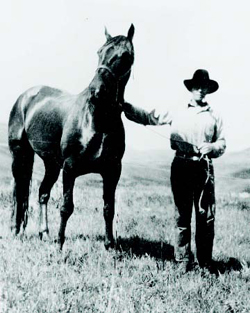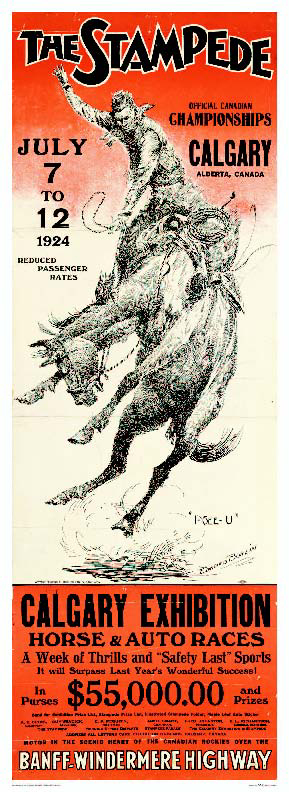Canada’s Greatest Bucking Horse
 |
| Jim McNab poses with Hall of Fame bronc, Midnight. The former saddle horse was halter broke and quiet to handle on the ground. So quiet in fact, that the young sons of rodeo promoter, Peter Welsh, would lead Midnight into the bucking chute. Photo courtesy Glenbow Museum |
He was foaled in 1915 on Jim McNab’s Cottonwood Ranch in southern Alberta’s Porcupine Hills. The lively black colt, sired by a Percheron-Morgan cross stud, was eventually gelded and broke to ride by the age of three. However, his temperament was unpredictable and his reactions swift and violent, and by the time the gelding was eight years old, McNab decided he was too dangerous as a saddle horse and decided to try him out as a rodeo bucking horse. Little did he know that the towering black bronc would go down in history as one of the greatest bucking horses in the world. The horse was called Midnight.
At first, McNab entered Midnight in local rodeos in the Fort Macleod area and the black appeared almost unridable. Contrary to persistent myths, Midnight had been ridden in his career. The first was Pete Bruisedhead from the Blood Reserve at Standoff, Alta., an outstanding rider and one of the first documented contestants ever to make a clean competition ride on Midnight at Fort Macleod, in July 1924. McNab then entered him in the 1924 Calgary Stampede. No cowboy was able to stick the wild bronc.
In 1925, Calgary entrepreneur and horseman Peter Welsh incorporated The Alberta Stampede Company with the idea to recreate a travelling Wild West show. Instead of featuring trick shooters and staged “attacks” as was popular south of the Medicine Line, Welsh featured the top riders and the toughest broncs around. Along with his flamboyant partner, “Strawberry Red” Woll, the two promoters purchased Midnight for an astounding $500. The roll call of the company’s stock pen was a Who’s Who of rodeo broncs: Tumbleweed, High Tower, Gravedigger, Five Minutes to Midnight and the notorious Midnight. Some of the famous cowboys hired by Welsh included Pete Vandermeer, Frank Sharp, Herb Matier, Shuswap Band Chief Joe Leonard, Jesse Coates, Frank Studnick, Leo Watrin, Alec La Framboise, Pete and Slim Forester, Norman Edge and Pete Knight.
The riding contests were real; an open rodeo competition in front of thousands of spectators from B.C.’s lower mainland to Montreal. Competing for the richest prize money in rodeo, the competitors had their expenses covered and travelled by rail car. They also received a lot of injuries doled out by the broncs.
 |
| 1924 CS poster featuring the art of Edward Borein. Entitled “I-See-U” the artwork is reputedly a tribute to Midnight, a spoiled saddle horse. Notice the cowboy is mounted in a full stock saddle complete with lariat, while the horse is packing a bosal with mecate reins; a traditional hackamore set. Photo courtesy Calgary Stampede Archives |
Midnight’s increasing notoriety soon earned him top billing on the rodeo posters, and his legend grew. The travelling cowboys discussed all of the black gelding’s moves in detail, and Pete Knight, who had yet to draw the bronc, listened avidly. It wasn’t until October 1926 at the Montreal Stampede held at Delormier Park that Pete Knight finally drew the black ‘streak of misery’.
On the following afternoon before a sold-out crowd, the former saddle horse Midnight was quietly led into the bucking chute. Knight’s saddle was cinched up and he lowered himself onto the famous outlaw.
The first jump out the horse fired into the arena, the impact from the second jump had Knight’s ears ringing and his nose began to bleed. By the third lunge, Knight was in his rhythmic spur lick. In the seventh second of the stands-clearing ride, Midnight whipped to the right, Knight blew his left stirrup and Midnight flung the cowboy high in the air, disqualifying Knight in the ninth second. (Back then, a qualified ride was ten seconds, it has since been lowered to eight.)
By the time the ride ended, Midnight was bleeding from spur-cuts down both flanks while the rider was bleeding from his nostrils and lips, his mouth slashed by his own teeth. Knight often claimed with no reservation that Midnight was one of the toughest horses of his career to ride.
By 1928, The Alberta Stampede Company was dissolved and its assets sold off, including famed broncs Midnight and Five Minutes to Midnight to American rodeo producer Colonel Jim Eskew. The broncs were then sold to Eddie McCarty and Vern Elliott, contractors to Cheyenne’s Frontier Days Rodeo.
Midnight was such a draw that by 1930, the renegade was again paired with top bronc rider Pete Knight in a paid exhibition ride at Cheyenne. Paid fifty dollars for the ride, Knight lasted seven and a half seconds before hitting the dust. A rumour started that he was paid to take a dive to enhance the horse’s reputation but Knight later told his brother Walt that while money had been offered to hit the dirt, he refused. He had given the horse an honest ride — and the horse won.
Three years later McCarty and Elliott retired Midnight. In 1934, the legendary bronc was brought out of retirement and shipped to England to star in ‘Tex’ Austin’s Cowboy Troupe — a month-long rodeo at the White City Stadium in London that proved to be a financial disaster.
Selling the lesser-known broncs at auction, the sentimental McCarty and Elliott brought both Midnight and Five Minutes to Midnight home to North America. A short two years later, the legendary Midnight died in Denver. His remains are now enshrined at the National Cowboy Hall of Fame in Oklahoma City.
In 1981, Midnight was the first horse inducted into the Canadian Professional Rodeo Hall of Fame.
References
Pete Knight: The Cowboy King
by Darrell Knight
Printed by Detselig Enterprises, Calgary
Stockmen’s Memorial Foundation Library and Archives, Cochrane












